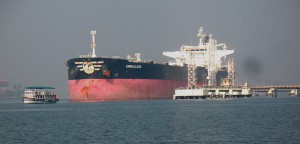Exactly one year and one month after committing the murder of two Indian fishermen off the coast of Kerala state, India, the buddy-pair of Italian marines has finally dodged the Indian judiciary to remain home in Rome. The collusion between the Indians and Italians to prevent the murderers from being tried under the Indian judicial system is an act of diplomatic and democratic treachery.
Those involved in aiding the escape of Italian marines have dashed the hopes of coastal multitudes that were counting on India to take a firm stand against Western powers for creating war zones on the high seas and killing with impunity.
Such unruly behavior is leading to non-compliance of basic norms related to rights of coastal nations in its waters. The merchant ships have a right to innocent passage in the territorial waters of another state, however the question is can they enjoy the immunity, if they are armed?

The problem is that the freedom of navigation of small fishing vessels and their legitimate right to indulge in economic activity is being curtailed by the same forces – global navies, private military companies (PMCs) and armed guards that seek to protect the inalienable right of big business to fearlessly ply on the sea lanes of communication.
The onerous task of safe guarding the private shipowners’ assets at sea demands establishment of ‘piracy zones’. Such zones are similar to ‘war zones’ where the warships of the adversaries are free to engage each other without the fear of being disturbed by neutrals or those not interested in the tussle.
Since piracy attacks remain undefined and unpredictable, it is dangerous to – declare vast areas of sea as war zones for prolonged durations. This is exactly what is happening in the piracy zones extending from the Somali coast right up to the Arabian Sea -where preemptive strikes are common, ostensibly in self-defence.
One such act happened in July last year, the US navy’s, USNS Rappahannock’s trigger happy firing squad took aim at a trawler in the sea off Jebel Ali, killing one Indian fisherman, Arumugam Sekar, and giving bullet wounds to three others. All this indiscriminate shooting is being dubbed as ‘military necessity’ of war against terrorism and piracy.
The trial of Italian armed guards in India is a test case being keenly watched by international maritime community that has revived the practice of arming the commercial shipping. Armed men onboard merchant shipping is an 18th century practice. That survived intermittently throughout the 19th century. It came back again with the First World War. This time the reasons for its revival were not rooted in piracy but the threat posed by German submarines.
On completion of the Second World War, the disarming of the merchant ships began in 1946, mainly because the global commons was now being commanded by the United States that wanted to redesign the governance structures on the high seas. Moreover, the US could not afford to let the Soviets have a right to arm the communist commercial shipping. Such a situation would have jeopardized the freedom of navigation. It would also have added an economic dimension to the cold war that was limited to the politico-military arena.
However, the end of cold war brought back piracy into the global maritime discourse, marking the return of re-arming the merchant ships with a vengeance. The private security and military companies are not limiting themselves to providing armed guards. They are provisioning armed vessels and drones in the piracy prone areas, directly challenging the role and missions of the conventional naval forces.
In the 1980s Typhoon class was synonymous with Soviet nuclear powered ballistic missile submarine, but the current ‘Typhoon’ class is a class in itself. The Telegraph, London, describes Typhoon as a $15m start-up private navy based in Abu Dabhi. Its chairman is a former French Foreign Legionnaire, non executives are, former commander of Allied Forces Northern Europe, ex-head of US naval forces in Europe, the foot soldiers are the elite ex-royal marines and to make the combination more lethal, you have former chief of HSBC’s marine and insurance business bringing with him the power to fleece.
It was only in 1856 that the world had abolished privateering – a form of piracy authorized by the governments to beat competition by indulging in outright loot. Since the world is once again treading the beaten tracks, it would not be difficult to predict that in the coming decade, the thin line dividing the privateer and a pirate will disappear and the seas will be as violent as they were in the past. Using Michael L. Niman wonderful expression to describe the “the sequester debates,” I conclude, the Indian maritime community must stop promoting the piracy delusions and refrain from “dutifully parroting choreographed memes and metaphorical names while otherwise remaining asleep at the wheel.”
There is nothing so dangerous and urgent about piracy that it demands a reversion to 18th naval century practices. The current game to reconfiguring the governance laws at sea, and privatize security at sea, a last ditch effort by the Churchills’ in America who loath to see their empire sinking.
The writer is a former naval officer and currently a Research Scholar at School of Liberal Studies, Ambedkar University, Delhi














Pingback: Back to Force at Sea | Purple Beret
Indepth. Sharing it on Facebook.